As the youth-led initiatives and their success stories around the world have shown, collective action from young people is already changing things for the better. Young people are the HOPE for the future as they are creative and fill of energy. Identifying youth leaders and supporting them in their efforts to be the leaders who could be a critical link between the government of India and the immigrant youth who are spread around the world.
With the objective of providing a youth forum that will provide a platform for the Disapor youth to help amplifying youth actions that will help create change in approach and programs by the Government of India, GOPIO International organized a virtual session on “India’s Outreach to Diaspora-Youth Perspective” on Sunday, March 7th, 2021. Attended by youth and senior leaders of the Diaspora from around the world, the event provided the participants a rare view into the youth and their perspectives on how the Diaspora youth power can be utilized creatively for the benefit of India and the world.
In his introductory remarks, after clarifying the role and the growth of GOPIO International, Dr. Thomas Abraham, Chairman of the GOPIO International pointed out that, “India has the largest Diaspora in the world and it is still growing. Currently, the Indian Diaspora has a strength of over 32 million people.” Referring to the numerous initiatives that the Government of India (GOI) has taken with the objective of reaching out to the Diaspora, Dr. Thomas Abraham pointed out to the Pravasi Bharatiya Divas held in India since 2013, which showcases to the fact that “India has great interest to reach out and cultivate its Diaspora youth. It has several programs for the Diaspora youth and exploring more avenues to outreach.”
In this context, Dr. Abraham said, GOPIO International is organizing a virtual Zoom session for Indian Diaspora Youth who are High School/College/University students as well as young professionals up to the age 25 on “India’s Outreach to the Diaspora – Youth Perspective,” with participants from different countries. “Today’s event is one such event to encourage the youth of Indian origin to aspire to be youth leaders and to help network youth from around the world with the Youth in every GOPIO Chapter around the world.
Ambassador Anup Mudgal, chief guest and main speaker today at the event, had served as India’s former Ambassador to Mauritius and Chair, Diaspora Research and Resource Centre, ARSP, New Delhi. In his inspiring address, Ambassador Mudgal pointed out that Antar-Rashtriya Sahayog Parishad has been in existence for over three years, under the Ministry of External Affairs. The objectives of the ARSP, according to Mudgal is “to take the intiativs with Diaspora to the next level: 1. Outreach to Diaspora; 2. Engage the youth of Indian origin; 3. Help the Diaspora in research and publication; 4. Expanding of Diaspora organizations around the world and in India.
According to Ambassador Mudgal, “Youth Diaspora is a main pillar of ARSP.” Emphasizing that the ideas and actions must be derived from the Diaspora, he pointed out that several of them have been accepted by the Govt.” Stating that the Indian Diaspora is one of the most successful in every domain, Ambassador Mudgal said, “You have done very well. You also enjoy tremendous good will among the host nations. Diaspora plays an important tool of power as each of you is the Ambassador of India.”
Suggesting that the “Engagement with the youth will be a regular phenomenon from now on,” he urged that the youth need to carry forward the flag to the upcoming generations. He asked the youth to reflect and find answers: “What makes the Indian Dispora stand out? What are the characteristics that make us successful? What are the changes we need to make to shine more? While your Indianness will always be with you, you need to understand how does that help shape your personality?”
The plan as per Ambassador Mudgal is that the Government of India will organize annual International conferences with representatives from 15 nations, during which the delegates will explore on the kind of relationship, engagement they expect from the Government of India. “This dialogue will continue for centuries to come,” he assured the participants.
The lively session attended by talented youth from the US and Europe was moderated by Beena Ramachandran of GOPIO CT. She said, two youth from the participants today will be chosen by a panel of Judges: Dr. Thomas Abraham, Anita Bhatt, Navin Pathak, Naumi Kaur. These 2 youth will attend the international youth conference to be held in April this year, she said.
Ananya Kotian, a Junior in high school aspiring to pursue an education in psychology, and is passionate about dance and singing, in her presentation pointed to how the media helps us to stay connected with India. Stating that how staying in touch with documentary makers, who creatively showcase the issues facing the people of India, Ananaya Kotian advocated for virtual cultural experiences. Founder of the blog Cultural Kaleidoscope, which delves into Asian culture from a young American Indian’s perspective, while pointing to the fact that many Diaspora leaders have been appointed to bigger roles in Biden administration, a tutor and STEM mentor for the Boys&Girls club, Kotian said, “We are successful because of the values we have inherited from our country of origin, India.”
Anjo George, a junior who is well-rounded in academic fields, music, swimming, and technology, and has been passionate about helping other students to improve their academics, highlighted the history of hosting Pravasi Bharatiya Divas, celebrating Diaspora’s contributions to India and help stay connected with India. While referring to the Know India Program by the Government of India, George said, “It helps us learn and promote Indian culture, while enabling us share our views and bond closely with India, and help reflect a positive image about India.” George suggested: 1. Cultural exchange at school levels; 2. Establish youth ambassadors with delegates from each country to discuss issues and propose solutions, modeling Model Congress/Model Youth; 3. Organize regular competitions on social issues faced by India; 4. Exploring and increasing study abroad programs and internships, this helping build leadership, culture and help make a global community of Indians.
Viswaa Sofat, a freshman at U.C. Berkeley studying Computer Science and Political Science, shared with the audience his experiences as someone who was both born and partially raised in India, and how he tries to remain strong and fundamental to his identity as a person of Indian origin. He hopes to use this opportunity to learn from other like-minded individuals and further involve Indian youth abroad. Vishwas Sofat said, he had immigrated to US at the age of 2. Later on, he returned to India, lived in India, modeling Israel how they attract youth to come to Israel. “Growing up in India helped me understand and appreciate the values, traditions, art and culture,” he said and added, “ India is at a critical junctures today with youth stepping up and joining protest movements in India.” He suggested for the Diaspora youth to be able to connect with Universities in India and get diverse perspectives through structured programs organized for them. Easy access to obtain visa.
Nithya Shenoy, a freshman at Rice University in Houston, Texas, plans to double major in political science and neuroscience. Is a part of Rice’s student-run paper, Thresher, and enjoys writing political pieces, reading, playing the violin, and Model UN. She shared about Israel’s Diaspora Outreach, “which helps develop collective identities, creates a sense of oneness,” she said. Referring to the African Nations Diaspora initoavesatives, she suggested to the need for grass root level outreach. Her recommendations included: 1. Scholarships through competitions with tourism component and education, which will help youth to become more connected. 2. Organize pent house programs, connecting with youth in other nations, and thus help understand how they perceive India. 3. Exposure through NGOs gives the youth an opening to understand and appreciate India better.
Vedant Gannu is a senior studying Computer Science at Rensselaer Polytechnic Institute and a Data Engineer Co-op at Ellington Management Group. A youth member of GOPIO CT for years, he served on the GOPIO Youth Committee, helped organize events such as Indian Independence day celebration and the annual Youth Networking event in Stamford. As a proud Indian and ambitious student, he is interested in helping the Diaspora Youth as they are integral members of the Indian community that will serve as role models for future generations. In his address, Gannu said, Education is the key to job opportunities. His suggestions included: 1. Mentorship and exchange programs will provide a combination of global with local perspectives; 2. Infrastructure planning for better structural models; 3. Indian Government agencies need to offer internships and hire the youth who can share global perspectives to local problems/issues; 4. Scholarships in less popular areas of study.
Alicia Kaur, a graduate of Rutgers University with a degree in Legal Studies, said, her dream is to one day become a lawyer and fight for racial justice and a more inclusive society. Coming from one of the most diverse universities in the United States and being a minority herself, she believes her personal experiences are what drive her towards this goal. A winner of the Women in Leadership Award from Ernst and Young, pointed out how, the Indian Diaspora has become the “most successful community in the US, as shining examples with many influential organizations has the highest per capita income, most educated, and holding influential positions around the nation, especially with dozens of Indian Americans appointed to top positions in Biden administration. Her suggestions included, the need for a new NRI policy; partnership with tech/research sectors; student exchange programs; and, collaboration in healthcare.
Abhi Parikh, currently living in Paris, and originally from Ahmedabad, India, said, she is involved in 2 start-ups, one is in the education sector and another in the food sector, and is immensely passionate about her work. Apart from that, she has started a few Indian communities on Facebook, just to gather Indian people on a common platform, she said. While suggesting that the youth have huge potential., she urged the government to tap this force through encouraging steps. She shared with the participants about how developing social media platforms help youth establish startups by youth. Focusing on entrepreneurial migration, she said, they help give access to information; access to network and sharing; access to business through exchange programs.
Akshat Gupta, a young professional in the field of Medical Technology, based in Munich, Germany, had moved out of India more than a decade ago in the pursuit of newer academic and career opportunities, and has had the good fortune of having worked and lived in multiple cultures. Stating that his leisurely activities include astronomy, sky-diving, and going off the grid once in a while, Gupta praised the ever changing dynamic of Indian diaspora, and suggested that the outreach programs by the Government of India needs to adapt and change according to the need and times. Connecting with various sub culures and diversification of missing links and helping them connect with the expats. Stressing that the Indian Missions around the world need to play a more active role in the life of Diaspora, Gupta said, he appreciates the new initiatives and would look forward to how the Government is able to listen to the perspectives of the youth and how these suggestions are being heard and acted upon.
In his concluding remarks, Dr. Abraham promised that “After the session, all ideas will be pooled to make recommendations which two of the youth from the session will speak at a Webinar organized by Antar-Rashtriya Sahayog Parishad (ARSP) from Delhi in April, 2021.”
 In addition to three days of Puja and all its special features, they also had an array of cultural programs with some legendary artists from both the USA as well as from India. Last two years, BAGC through its strong tech committee has continued connecting with the community virtually due to the challenges posed by Covid-19 Pandemic through BAGC Live YouTube channel and BAGC Radio in showcasing its virtual events to the entire community across the globe.
In addition to three days of Puja and all its special features, they also had an array of cultural programs with some legendary artists from both the USA as well as from India. Last two years, BAGC through its strong tech committee has continued connecting with the community virtually due to the challenges posed by Covid-19 Pandemic through BAGC Live YouTube channel and BAGC Radio in showcasing its virtual events to the entire community across the globe.
 The number of Catholics in the world grew by more than 15 million from 2018 to 2019, according to a census by the Vatican news agency Fides published on Thursday (Oct. 21). “The increase applies to all continents, except Europe,” which saw the number of Catholic faithful decrease by almost 300,000, the survey found.
The number of Catholics in the world grew by more than 15 million from 2018 to 2019, according to a census by the Vatican news agency Fides published on Thursday (Oct. 21). “The increase applies to all continents, except Europe,” which saw the number of Catholic faithful decrease by almost 300,000, the survey found. The first female governor of the great state of New York thanbked the organiZers and leaders of the Indian American community: “I want to just thank Uma SenGupta for all you’ve done for us, and to your family, your mother, and the influence of your late father – you are the reason why we celebrate today, people like you who came to this country humbly, not sure of what the future would bring, but you always had that deep rooted faith in your traditions and to know that Diwali followed you to this country, that you had this light within your heart that you could bring to America and let shine and let all of us gather here in honor of the Goddess Lakshmi. Many of the traditions honor the male gods but this is one that’s dedicated to women so I think this is particularly special as well. Dr. Sumita Sengupta, I want to thank you as well. Randhir Jaiswal, the Consul General, is here as well. Dr. Hari Shukla, I want to thank him for making me feel so welcome, the founder of South Asians of New York.”
The first female governor of the great state of New York thanbked the organiZers and leaders of the Indian American community: “I want to just thank Uma SenGupta for all you’ve done for us, and to your family, your mother, and the influence of your late father – you are the reason why we celebrate today, people like you who came to this country humbly, not sure of what the future would bring, but you always had that deep rooted faith in your traditions and to know that Diwali followed you to this country, that you had this light within your heart that you could bring to America and let shine and let all of us gather here in honor of the Goddess Lakshmi. Many of the traditions honor the male gods but this is one that’s dedicated to women so I think this is particularly special as well. Dr. Sumita Sengupta, I want to thank you as well. Randhir Jaiswal, the Consul General, is here as well. Dr. Hari Shukla, I want to thank him for making me feel so welcome, the founder of South Asians of New York.” It has been reported that President Biden will meet with Francis on October 29th. While serving as the U.S. Vice President, Biden had met with Pope Francis for the first time in September 2015, when the pope visited the United States to attend the World Meeting of Families in Philadelphia.
It has been reported that President Biden will meet with Francis on October 29th. While serving as the U.S. Vice President, Biden had met with Pope Francis for the first time in September 2015, when the pope visited the United States to attend the World Meeting of Families in Philadelphia. Francis’ private meeting with Pelosi, a Catholic and a defender of abortion rights, came as American Catholic bishops consider how to press the church’s teaching against abortion while the country’s second Catholic president, Joe Biden, heads an avowedly pro-choice Democratic administration
Francis’ private meeting with Pelosi, a Catholic and a defender of abortion rights, came as American Catholic bishops consider how to press the church’s teaching against abortion while the country’s second Catholic president, Joe Biden, heads an avowedly pro-choice Democratic administration The speaker, in her statement on the meeting, emphasized the pontiff’s support for measures to combat climate change. “His Holiness’s encyclical Laudato Si’ is a powerful challenge to the global community to act decisively on the climate crisis with special attention to the most vulnerable communities.” She went on to praise “the immense moral clarity and urgency that His Holiness continues to bring to the climate crisis.”
The speaker, in her statement on the meeting, emphasized the pontiff’s support for measures to combat climate change. “His Holiness’s encyclical Laudato Si’ is a powerful challenge to the global community to act decisively on the climate crisis with special attention to the most vulnerable communities.” She went on to praise “the immense moral clarity and urgency that His Holiness continues to bring to the climate crisis.” Rep. Krishnamoorthi, said he joins the many Hindu faithful in the United States in recognizing October as Hindu Heritage Month. Several Hindu organizations in the U.S., including Vishwa Hindu Parishad of America (VHPA), have declared October as Hindu Heritage Month, and several states including New Jersey, Delaware, Ohio, Texas, Florida, Nevada, North Carolina, Minnesota, Virginia and Massachusetts have proclaimed October as Hindu Heritage Month, according to the website hindumonth.org, as have several cities like Dallas, TX, and La Palma, CA.
Rep. Krishnamoorthi, said he joins the many Hindu faithful in the United States in recognizing October as Hindu Heritage Month. Several Hindu organizations in the U.S., including Vishwa Hindu Parishad of America (VHPA), have declared October as Hindu Heritage Month, and several states including New Jersey, Delaware, Ohio, Texas, Florida, Nevada, North Carolina, Minnesota, Virginia and Massachusetts have proclaimed October as Hindu Heritage Month, according to the website hindumonth.org, as have several cities like Dallas, TX, and La Palma, CA. Since then, Pandher, who lives in a remote cabin in the Yukon, has become an international YouTube sensation. He views the dance videos as a way to spread positivity and cross-cultural understanding — a calling he’s especially taken seriously since March 2020. A March 2, 2021, video of Pandher, with his signature animated grin, dancing on a frozen lake after getting his first dose of the COVID vaccine has more than 3 million views on Twitter. Collectively, his videos have been watched more than 50 million times. In September, he was featured on YouTube billboards across Canada that read, “Taught people to dance. Moved the whole country.”
Since then, Pandher, who lives in a remote cabin in the Yukon, has become an international YouTube sensation. He views the dance videos as a way to spread positivity and cross-cultural understanding — a calling he’s especially taken seriously since March 2020. A March 2, 2021, video of Pandher, with his signature animated grin, dancing on a frozen lake after getting his first dose of the COVID vaccine has more than 3 million views on Twitter. Collectively, his videos have been watched more than 50 million times. In September, he was featured on YouTube billboards across Canada that read, “Taught people to dance. Moved the whole country.” According to the Library of Congress, Jefferson’s Quran will be the “first object on display after guests emerge from a sound and light experience that showcases the U.S. founding principles, particularly its innovations. Jefferson and the Quran are the first example of those goals.” The pavilion will also feature a SpaceX rocket and rock taken from the Moon during a NASA mission.
According to the Library of Congress, Jefferson’s Quran will be the “first object on display after guests emerge from a sound and light experience that showcases the U.S. founding principles, particularly its innovations. Jefferson and the Quran are the first example of those goals.” The pavilion will also feature a SpaceX rocket and rock taken from the Moon during a NASA mission. A young Dalit girl, with the dream of becoming a dancer in her eyes, and her soul mate Bheem leave their caste-ridden existence behind and relocate to Bombay. They have learnt the hard way that the preaching of oneness by their religion does not work in the real world. Drawing its title, “Two and a half Rivers” (Niyogi Books), from the historicity of the Partition which has left in its wake only half the rivers to India from the land of the five rivers, Anirudh Kala’s novel offers a poignant commentary on the turbulent connection between religion and terrorism.
A young Dalit girl, with the dream of becoming a dancer in her eyes, and her soul mate Bheem leave their caste-ridden existence behind and relocate to Bombay. They have learnt the hard way that the preaching of oneness by their religion does not work in the real world. Drawing its title, “Two and a half Rivers” (Niyogi Books), from the historicity of the Partition which has left in its wake only half the rivers to India from the land of the five rivers, Anirudh Kala’s novel offers a poignant commentary on the turbulent connection between religion and terrorism. Also on this episode,
Also on this episode, 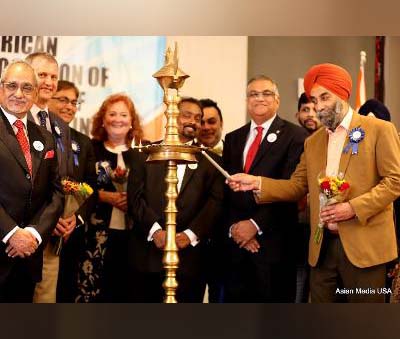 The event started with national Anthems and lamp lighting followed by the inaugural dance performance by the students of SR Dance Academy. The master of ceremony Madhura Sane kickstarted the event by welcoming all the board of directors and the distinguished guest on to the stage. The President Gladson Varghese delivered his speech to elaborate on the vision behind the initiative of launching AAEIO. He talked about how the organization aims at supporting engineers across the globe by providing them a voice and guidance by the experienced leadership of the organization. Vice President Nitin Maheshweri presented the Vision and 4 pillars of the organization. Chief Guest Consul General of India Mr. Amit Kumar along with Congressman Sean Casten officially Inaugurated the AAEIO by lighting the Lamp. AAEIO also presented the awards to Dr. Deepak Kant Vyas, Mr. Gulzar Singh and Mr. Brij Sharma for their contributionsto the community and becoming successful Engineering Entrepreneurs.
The event started with national Anthems and lamp lighting followed by the inaugural dance performance by the students of SR Dance Academy. The master of ceremony Madhura Sane kickstarted the event by welcoming all the board of directors and the distinguished guest on to the stage. The President Gladson Varghese delivered his speech to elaborate on the vision behind the initiative of launching AAEIO. He talked about how the organization aims at supporting engineers across the globe by providing them a voice and guidance by the experienced leadership of the organization. Vice President Nitin Maheshweri presented the Vision and 4 pillars of the organization. Chief Guest Consul General of India Mr. Amit Kumar along with Congressman Sean Casten officially Inaugurated the AAEIO by lighting the Lamp. AAEIO also presented the awards to Dr. Deepak Kant Vyas, Mr. Gulzar Singh and Mr. Brij Sharma for their contributionsto the community and becoming successful Engineering Entrepreneurs.  Dr. Mohanbir Sawhney, Associate Dean, (Northwestern University, Kellogg) delivered an inspirational and informative keynote speech elaborating on his experience and the roles and future of organizations like AAEIO. The speech by the Vice President 2021 Nitin Maheshwari included the plans for the upcoming initiatives taken by AAEIO and how the organization aims at supporting small businesses, fresh graduates as well as the fellow engineers from all across the globe. The president elect 2021 Ajit Pant talked about how AAEIO will act as an umbrella organization for the engineers from all streams of engineering like civil, mechanical, IT, electronics, Electrical and so on. Nag Jaiswal did the Vote of Thanks and he thanked all the sponsors, Dignitaries, AAEO Board and all the Guests for their help and support.
Dr. Mohanbir Sawhney, Associate Dean, (Northwestern University, Kellogg) delivered an inspirational and informative keynote speech elaborating on his experience and the roles and future of organizations like AAEIO. The speech by the Vice President 2021 Nitin Maheshwari included the plans for the upcoming initiatives taken by AAEIO and how the organization aims at supporting small businesses, fresh graduates as well as the fellow engineers from all across the globe. The president elect 2021 Ajit Pant talked about how AAEIO will act as an umbrella organization for the engineers from all streams of engineering like civil, mechanical, IT, electronics, Electrical and so on. Nag Jaiswal did the Vote of Thanks and he thanked all the sponsors, Dignitaries, AAEO Board and all the Guests for their help and support. 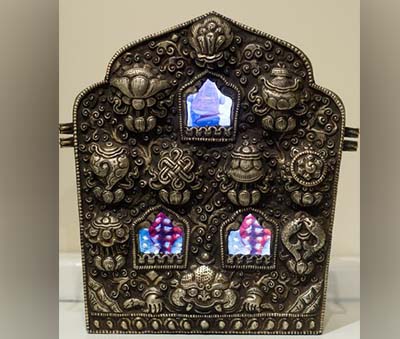 Aharoni’s work is also on view at
Aharoni’s work is also on view at  “I wanted to start the foundation so that we could raise awareness so that we could increase funding on a federal level, so that we could lobby insurance companies to pay for women getting checked out properly,” she was quoted as saying by Variety. “I don’t want any young woman in the next generation to go through what I and millions of women have gone through.”
“I wanted to start the foundation so that we could raise awareness so that we could increase funding on a federal level, so that we could lobby insurance companies to pay for women getting checked out properly,” she was quoted as saying by Variety. “I don’t want any young woman in the next generation to go through what I and millions of women have gone through.”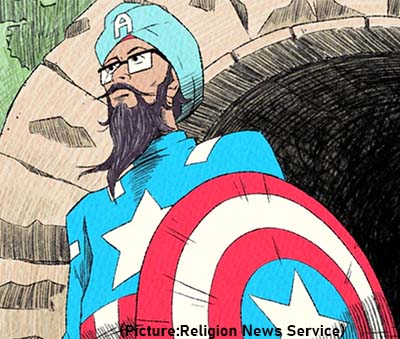 Now, an animated feature, “American Sikh,” is set to chronicle his life, from his time in India, where his family survived the
Now, an animated feature, “American Sikh,” is set to chronicle his life, from his time in India, where his family survived the 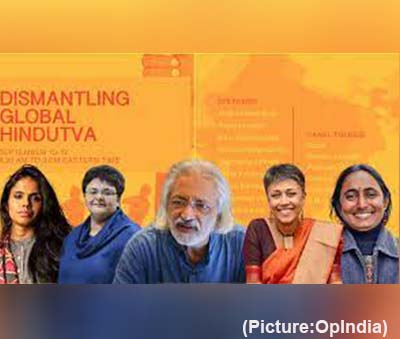 The organizers claim, Hindutva Is Not Hinduism. In a statement signed by nearly 1,000 leading professionals and academicians stated: “As scholars and members of academic communities around the world, we strongly condemn the campaign of harassment and intimidation against the Dismantling Global Hindutva conference, and stand in solidarity with the 49+ universities and 60+ departments and centers sponsoring the event.” They opposed the “besieging of cosponsoring institutions by political extremists who have disingenuously sought to smear the conference as “Hinduphobic” or “anti-Hindu.” We firmly reject these misleading attempts to conflate Hindutva and Hinduism.”
The organizers claim, Hindutva Is Not Hinduism. In a statement signed by nearly 1,000 leading professionals and academicians stated: “As scholars and members of academic communities around the world, we strongly condemn the campaign of harassment and intimidation against the Dismantling Global Hindutva conference, and stand in solidarity with the 49+ universities and 60+ departments and centers sponsoring the event.” They opposed the “besieging of cosponsoring institutions by political extremists who have disingenuously sought to smear the conference as “Hinduphobic” or “anti-Hindu.” We firmly reject these misleading attempts to conflate Hindutva and Hinduism.”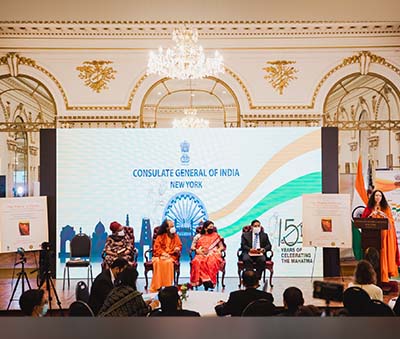 The event was attended, among others, by the Secretary-General, Religions for Peace Prof. Azza Karam; secretary-general, Global Interfaith WASH Alliance, Parmarth Niketan; Special Adviser to the Secretary-General of the UN and head of the United Nations Office of Genocide Prevention, Alice Nderitu; President of Parmarth Niketan and founder and chair of Global Interfaith WASH Alliance, Swami Chidanand Saraswati; India’s Minister of State for External Affairs & Culture, Meenakshi Lekhi; Consul General of India to New York Randhir Jaiswal; President/Founder of the International Academy for Multicultural Cooperation, President of the Light of Awareness International Spiritual Family Audrey Kitagawa, JD; Padma Shri Dr. Sudhir Parikh, chairman of Parikh Worldwide Media and ITV Gold; and Jonathan Granoff, president, Global Security Institute.
The event was attended, among others, by the Secretary-General, Religions for Peace Prof. Azza Karam; secretary-general, Global Interfaith WASH Alliance, Parmarth Niketan; Special Adviser to the Secretary-General of the UN and head of the United Nations Office of Genocide Prevention, Alice Nderitu; President of Parmarth Niketan and founder and chair of Global Interfaith WASH Alliance, Swami Chidanand Saraswati; India’s Minister of State for External Affairs & Culture, Meenakshi Lekhi; Consul General of India to New York Randhir Jaiswal; President/Founder of the International Academy for Multicultural Cooperation, President of the Light of Awareness International Spiritual Family Audrey Kitagawa, JD; Padma Shri Dr. Sudhir Parikh, chairman of Parikh Worldwide Media and ITV Gold; and Jonathan Granoff, president, Global Security Institute. After the ceremonial lighting of the lamp and recitation of auspicious prayers, Sadhvi Bhagawatiji presented each of the dignitaries on the dais a copy of Hollywood to the Himalayas. Minister of State for External Affairs and Culture Meenakshi Lekhi praised the Indian-American community for its devotion to the well-being of India. “Let me say at the outset how proud I am of all of you. We, in India, are extremely grateful to our diaspora which carries on all the traditional functions and are the ‘Ambassadors of India’ while the formal Ambassadors have formal jobs to do. But the ‘informal ambassadors’ carry the job far, far, far better and reach out to people,” Lekhi said. “The values that India stands for are exhibited by people who are away from their homes, but carry their hearts on their sleeves and always believe in and stand up for Mother India,,” she added.
After the ceremonial lighting of the lamp and recitation of auspicious prayers, Sadhvi Bhagawatiji presented each of the dignitaries on the dais a copy of Hollywood to the Himalayas. Minister of State for External Affairs and Culture Meenakshi Lekhi praised the Indian-American community for its devotion to the well-being of India. “Let me say at the outset how proud I am of all of you. We, in India, are extremely grateful to our diaspora which carries on all the traditional functions and are the ‘Ambassadors of India’ while the formal Ambassadors have formal jobs to do. But the ‘informal ambassadors’ carry the job far, far, far better and reach out to people,” Lekhi said. “The values that India stands for are exhibited by people who are away from their homes, but carry their hearts on their sleeves and always believe in and stand up for Mother India,,” she added.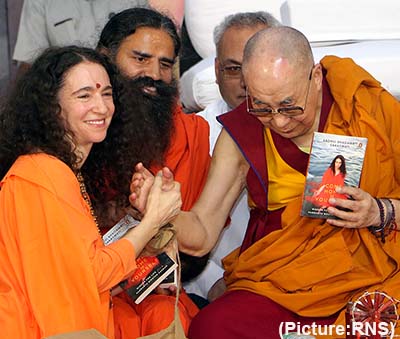 Sadhvi Bhagawati Saraswati,
Sadhvi Bhagawati Saraswati, When you talk about grace, a lot of people might think you mean the Christian concept of grace, a free gift usually associated with belief in Jesus. What do you mean by grace?
When you talk about grace, a lot of people might think you mean the Christian concept of grace, a free gift usually associated with belief in Jesus. What do you mean by grace? How we did this In 2019, roughly half of Hindu voters (49%) supported the BJP, giving the party a majority in the Lok Sabha – India’s lower house of parliament – and allowing Prime Minister Narendra Modi a
How we did this In 2019, roughly half of Hindu voters (49%) supported the BJP, giving the party a majority in the Lok Sabha – India’s lower house of parliament – and allowing Prime Minister Narendra Modi a  “In spite of
“In spite of  Marking the end of monsoons and welcoming the harvest season, this Kerala festival, Onam 2021 is a Hindu festival celebrated annually. It is celebrating all over India with its origin in the Kerala state. One of the biggest festivals of the state, the Onam festival is celebrating for 10 days. Normally it is during the Malayalam month of Chingam. It fills the heart of people with gaiety and brings them together to be a part of this vibrant and cultural festival.
Marking the end of monsoons and welcoming the harvest season, this Kerala festival, Onam 2021 is a Hindu festival celebrated annually. It is celebrating all over India with its origin in the Kerala state. One of the biggest festivals of the state, the Onam festival is celebrating for 10 days. Normally it is during the Malayalam month of Chingam. It fills the heart of people with gaiety and brings them together to be a part of this vibrant and cultural festival.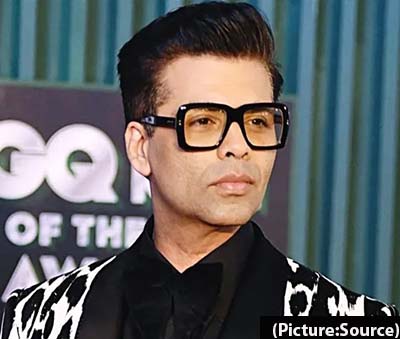 The film opens on a calm evening on a serene beach. We hear the sounds of waves gently crashing on the shore, seagulls cooing, and other ambient sounds. It is then that the frame spans out and we see Karan Johar saying: “Some sights take you places.” The teaser then ends with Karan Johar mentioning: “Something inspiring, clicking soon. Stay tuned!” On India’s Independence Day, Sonu Sood – actor, film producer, model, humanitarian, and philanthropist – had a special surprise announcement for all his fans! He announced a what-looks-to-be-like new project titled ‘It Happens Only in India’ with National Geographic India.
The film opens on a calm evening on a serene beach. We hear the sounds of waves gently crashing on the shore, seagulls cooing, and other ambient sounds. It is then that the frame spans out and we see Karan Johar saying: “Some sights take you places.” The teaser then ends with Karan Johar mentioning: “Something inspiring, clicking soon. Stay tuned!” On India’s Independence Day, Sonu Sood – actor, film producer, model, humanitarian, and philanthropist – had a special surprise announcement for all his fans! He announced a what-looks-to-be-like new project titled ‘It Happens Only in India’ with National Geographic India.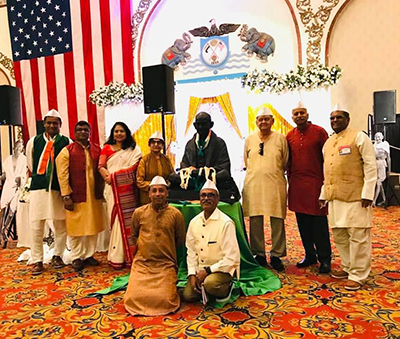 The event also raised funds for providing ambulances to help the secondary health sector in rural and tribal areas of India. Gandhian Society founder Bhadra Butala said that the society has committed to provide 50 ambulances this year, which will be run and maintained by Gandhian groups in the rural and tribal areas. The event on August 15th raised funds for 10 ambulances.
The event also raised funds for providing ambulances to help the secondary health sector in rural and tribal areas of India. Gandhian Society founder Bhadra Butala said that the society has committed to provide 50 ambulances this year, which will be run and maintained by Gandhian groups in the rural and tribal areas. The event on August 15th raised funds for 10 ambulances.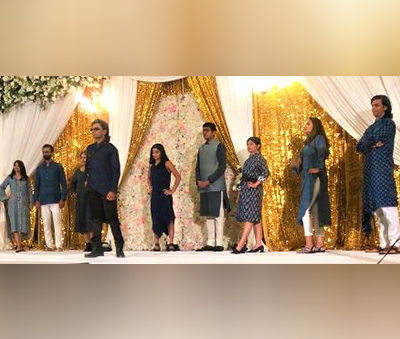 “When India was hit badly with the second wave of Covid, the Indian Diaspora came forward to help by sending oxygen concentrators and medical supplies and GOPIO chapters are supporting the noble cause of the Gandhian Society to provide ambulances to underserved rural and tribal areas,” Dr. Abraham added. Rep. Raj Mukerji said, “Mahatma Gandhi has been an inspiration to many leaders in the USA like Martin Luther King, President Obama and he himself is a big admirer of the Mahatma for the values that he propagated during his lifetime.”NJ Utilities Commissioner Chivukula said “the teachings of Mahatma are still relevant today and that the values system of the mahatma is identified with the Diaspora.” Chivukula hoped that the future generation will continue to uphold and keep these values of the greatest man from India.
“When India was hit badly with the second wave of Covid, the Indian Diaspora came forward to help by sending oxygen concentrators and medical supplies and GOPIO chapters are supporting the noble cause of the Gandhian Society to provide ambulances to underserved rural and tribal areas,” Dr. Abraham added. Rep. Raj Mukerji said, “Mahatma Gandhi has been an inspiration to many leaders in the USA like Martin Luther King, President Obama and he himself is a big admirer of the Mahatma for the values that he propagated during his lifetime.”NJ Utilities Commissioner Chivukula said “the teachings of Mahatma are still relevant today and that the values system of the mahatma is identified with the Diaspora.” Chivukula hoped that the future generation will continue to uphold and keep these values of the greatest man from India. The traditions of Jainism were largely carried forward by a succession of 24 tirthankaras, or teachers, most notably Vardhamana Mahavira, the last of the tirthankaras and likely a contemporary of Gautama Buddha. Both Mahavira and Buddha emphasized the importance of self-discipline, meditation and ascetic life as the key to salvation. Their teachings often stood in contrast to those of
The traditions of Jainism were largely carried forward by a succession of 24 tirthankaras, or teachers, most notably Vardhamana Mahavira, the last of the tirthankaras and likely a contemporary of Gautama Buddha. Both Mahavira and Buddha emphasized the importance of self-discipline, meditation and ascetic life as the key to salvation. Their teachings often stood in contrast to those of 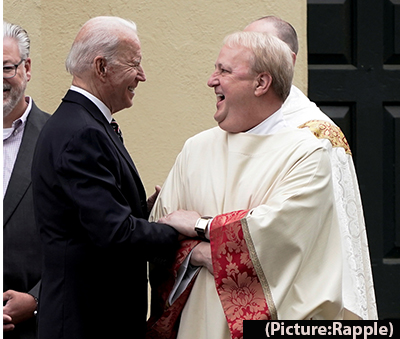 Bishop Kevin C. Rhoades, who leads the doctrine committee of the U.S. Conference of Catholics Bishops, reiterated that the document will not bar any individuals from receiving Communion and said it is “going to be addressed to all Catholics, not a particular person or a single issue in the part on Eucharistic consistency.”
Bishop Kevin C. Rhoades, who leads the doctrine committee of the U.S. Conference of Catholics Bishops, reiterated that the document will not bar any individuals from receiving Communion and said it is “going to be addressed to all Catholics, not a particular person or a single issue in the part on Eucharistic consistency.”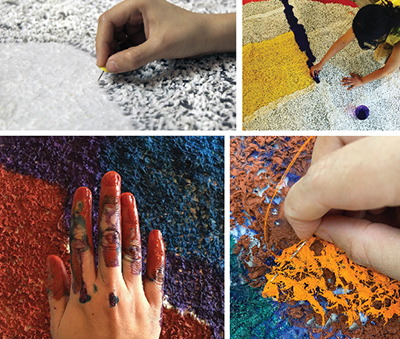 She then paints and sews together the lace-like constructions, creating richly colored abstract compositions. It is a deliberative and labor-intensive process that makes time itself an integral force in each work.
She then paints and sews together the lace-like constructions, creating richly colored abstract compositions. It is a deliberative and labor-intensive process that makes time itself an integral force in each work.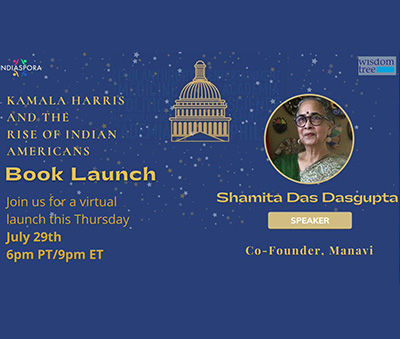 Published in India and available on Amazon around the world, the book, laid out in leisurely 341 pages, chronicles the progress and accomplishments of Indian Americans in 16 essays — from politics, entrepreneurship, technology, medicine, to science, business, entertainment, social activism, etc.
Published in India and available on Amazon around the world, the book, laid out in leisurely 341 pages, chronicles the progress and accomplishments of Indian Americans in 16 essays — from politics, entrepreneurship, technology, medicine, to science, business, entertainment, social activism, etc. Since it did not fall under the “I disobeyed my parents and fought with my siblings” script of kids’ confessions, I never brought it up in confession. (What does an orphaned only child confess?)
Since it did not fall under the “I disobeyed my parents and fought with my siblings” script of kids’ confessions, I never brought it up in confession. (What does an orphaned only child confess?) Nations work hard to get their wilderness areas, archaeological treasures, and cultural sites on the list, which includes some 1,153 properties around the world. Inscription brings prestige and public awareness, and it can lead to all sorts of good things: tourism revenue, renewed commitments to preserve irreplaceable assets, and public and private funding for restoration work. (Pictured below, this Russian Orthodox chapel and pavilion is part of another selection, the Darmstadt Artists’ Colony on Mathildenhöhe, in Germany.)
Nations work hard to get their wilderness areas, archaeological treasures, and cultural sites on the list, which includes some 1,153 properties around the world. Inscription brings prestige and public awareness, and it can lead to all sorts of good things: tourism revenue, renewed commitments to preserve irreplaceable assets, and public and private funding for restoration work. (Pictured below, this Russian Orthodox chapel and pavilion is part of another selection, the Darmstadt Artists’ Colony on Mathildenhöhe, in Germany.) Ashwagandha (Withania Somnifera), commonly known as ‘Indian winter cherry’, is a traditional Indian herb that boosts energy, reduces stress, and makes the immune system stronger.
Ashwagandha (Withania Somnifera), commonly known as ‘Indian winter cherry’, is a traditional Indian herb that boosts energy, reduces stress, and makes the immune system stronger.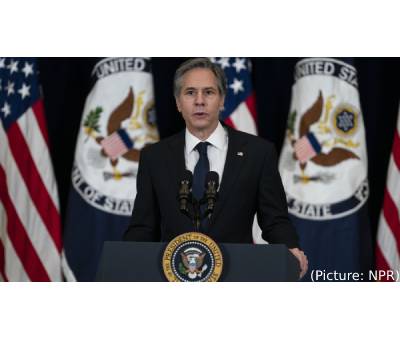 Blinken arrived in India on July 27th to discuss strengthening Indo-Pacific engagement, seen as a counter to China, as well as New Delhi’s recent human rights record and other issues. Blinken’s visit included meetings with Prime Minister Narendra Modi and senior officials on Wednesday, and was held just days after his No. 2 diplomat, Wendy Sherman, was in China for
Blinken arrived in India on July 27th to discuss strengthening Indo-Pacific engagement, seen as a counter to China, as well as New Delhi’s recent human rights record and other issues. Blinken’s visit included meetings with Prime Minister Narendra Modi and senior officials on Wednesday, and was held just days after his No. 2 diplomat, Wendy Sherman, was in China for 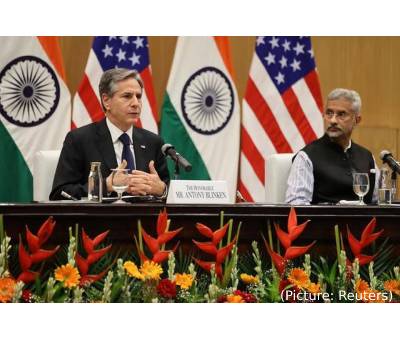 Jaishankar said he made three points to Blinken, including the fact that the “quest for a more perfect union applies as much to the Indian democracy as it does to the American one”.Ahead of Blinken’s visit, India’s
Jaishankar said he made three points to Blinken, including the fact that the “quest for a more perfect union applies as much to the Indian democracy as it does to the American one”.Ahead of Blinken’s visit, India’s 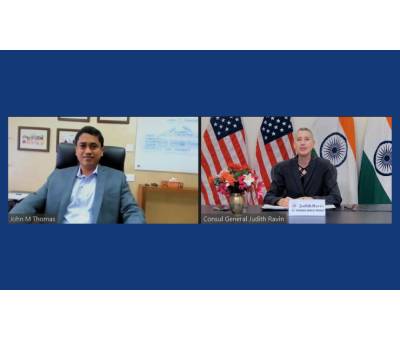 She was welcomed to the city by C.V. Ranvindra, a leading economist and the director of Thiruvananthapuram’s International airport. In his discussion with the Consul General, he explained the Kerala Model of Development, which emphasizes both the traditional and modern sectors like IT, tourism, space technology, and coastal infrastructure. She was also led on a virtual tour of the Government of Kerala’s Technopark by its CEO John M. Thomas. Technopark is the largest IT Park in India. Representatives from 7 major Indian and U.S. IT companies met with the General Consul to discuss Kerala’s current business environment.
She was welcomed to the city by C.V. Ranvindra, a leading economist and the director of Thiruvananthapuram’s International airport. In his discussion with the Consul General, he explained the Kerala Model of Development, which emphasizes both the traditional and modern sectors like IT, tourism, space technology, and coastal infrastructure. She was also led on a virtual tour of the Government of Kerala’s Technopark by its CEO John M. Thomas. Technopark is the largest IT Park in India. Representatives from 7 major Indian and U.S. IT companies met with the General Consul to discuss Kerala’s current business environment.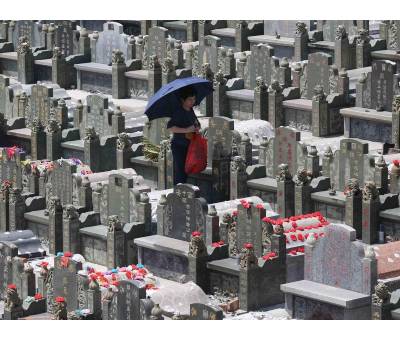 Cultural sites include a Chinese city once known as “the emporium of the world.” An important stop on the Silk Road, Quanzhou’s tapestry of ancient bridges and pagodas also includes one of the oldest mosques in China and other glimmers of the workings of a vibrant 10th-century city. The selection puts China near the top of the list of countries with the most World Heritage sites — right after Italy, which was granted another World Heritage site this year for
Cultural sites include a Chinese city once known as “the emporium of the world.” An important stop on the Silk Road, Quanzhou’s tapestry of ancient bridges and pagodas also includes one of the oldest mosques in China and other glimmers of the workings of a vibrant 10th-century city. The selection puts China near the top of the list of countries with the most World Heritage sites — right after Italy, which was granted another World Heritage site this year for 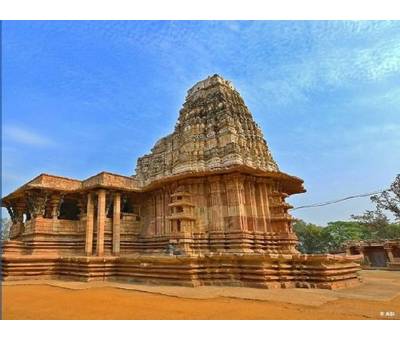 A World Heritage Site is a location with an “outstanding universal value”. This signifies “cultural and/or natural significance which is so exceptional as to transcend national boundaries and to be of common importance for present and future generations of all humanity”. To be included, sites must meet at least one of the ten selection criteria.
A World Heritage Site is a location with an “outstanding universal value”. This signifies “cultural and/or natural significance which is so exceptional as to transcend national boundaries and to be of common importance for present and future generations of all humanity”. To be included, sites must meet at least one of the ten selection criteria.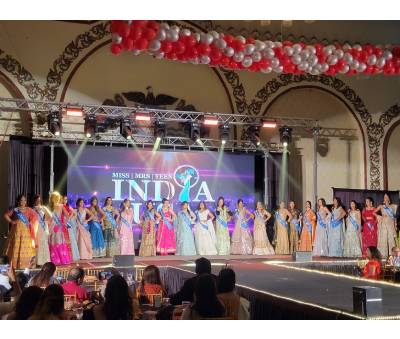 Vaidehi Dongre, 25, a graduate of University of Michigan with International Business as Major, currently employed as Business Development Manager with New Zealand Trade Commission, won the coveted Miss India USA 2021 Pageant on Friday, July 16th at Royal Alberts Palace, Edison, NJ. Organized by the New York based India Festival Committee (IFC) and chaired by Neelam & Dharmatma Saran, this is the longest running Indian pageant outside of India.” I am overwhelmed with the great response this year, said Dharmatma Saran, “with a record number of 61 contestants representing 30 states from across the United States.”
Vaidehi Dongre, 25, a graduate of University of Michigan with International Business as Major, currently employed as Business Development Manager with New Zealand Trade Commission, won the coveted Miss India USA 2021 Pageant on Friday, July 16th at Royal Alberts Palace, Edison, NJ. Organized by the New York based India Festival Committee (IFC) and chaired by Neelam & Dharmatma Saran, this is the longest running Indian pageant outside of India.” I am overwhelmed with the great response this year, said Dharmatma Saran, “with a record number of 61 contestants representing 30 states from across the United States.”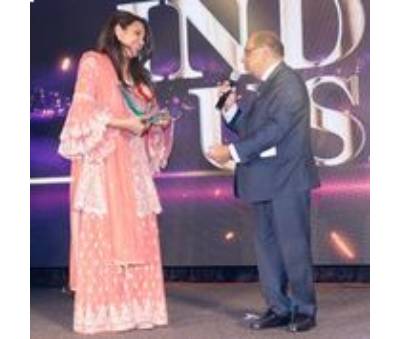 Sonal Dua, 36, from North Carolina won the Mrs Talented Title; Mrs Congeniality was Mohana Namle, 35, from Connecticut. Harshada Patil Fegade, 32 walked away with the Mrs Catwalk Title. Mrs Photogenic was Aparna Chakravarty, 55 from Florida; Mrs Popularity was Swathy Vimalkumar, 32 of Connecticut, and Mrs Chairman Professional was Sheetal Rana, 36 from New York. Amelia Mallareddy from North Carolina was declared Miss Beautiful Face, while Miss Catwalk was Mira Kasari from North Carolina. Rishika Pal of Massachusetts took the
Sonal Dua, 36, from North Carolina won the Mrs Talented Title; Mrs Congeniality was Mohana Namle, 35, from Connecticut. Harshada Patil Fegade, 32 walked away with the Mrs Catwalk Title. Mrs Photogenic was Aparna Chakravarty, 55 from Florida; Mrs Popularity was Swathy Vimalkumar, 32 of Connecticut, and Mrs Chairman Professional was Sheetal Rana, 36 from New York. Amelia Mallareddy from North Carolina was declared Miss Beautiful Face, while Miss Catwalk was Mira Kasari from North Carolina. Rishika Pal of Massachusetts took the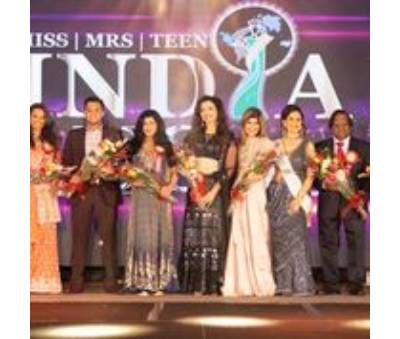 Diana Hayden, a popular Indian actress from Bollywood and Miss World 1997 was the Chief Guest. Shruthi Bekal, Mrs India USA 2019 and Tarna Kaur, Mrs India Worldwide 2019 elegantly emceed the pageant. Kim Kunari, former Miss India USA 2019 and Easha Kode, the first ever Miss Teen India USA were emcees for the pre-pageant event on July 15th. Nishi Bahl was the choreographer assisted by Shilpa Jhurani. This year’s pageant was presented by Yash Pandya and supported by TV Asia and Royal Albert’s Palace. Yash Pandya, Albert Jassani and H R Shah sashed the winners at the pageant.
Diana Hayden, a popular Indian actress from Bollywood and Miss World 1997 was the Chief Guest. Shruthi Bekal, Mrs India USA 2019 and Tarna Kaur, Mrs India Worldwide 2019 elegantly emceed the pageant. Kim Kunari, former Miss India USA 2019 and Easha Kode, the first ever Miss Teen India USA were emcees for the pre-pageant event on July 15th. Nishi Bahl was the choreographer assisted by Shilpa Jhurani. This year’s pageant was presented by Yash Pandya and supported by TV Asia and Royal Albert’s Palace. Yash Pandya, Albert Jassani and H R Shah sashed the winners at the pageant.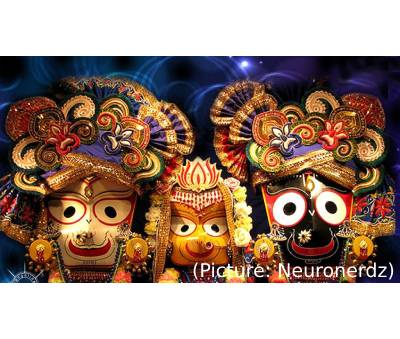 At the JagannathPuri shrine, Shri Jagannathji, Subhadraji, and Balabhadraji are revered and they ride in separate chariots during the RathYatra to their aunt’s residence, the Gundicha temple. After an eight-day visit, they return to Puri temple. For the unversed, the distance between Jagannath temple and Gundicha temple is around three kilometres. The idols o
At the JagannathPuri shrine, Shri Jagannathji, Subhadraji, and Balabhadraji are revered and they ride in separate chariots during the RathYatra to their aunt’s residence, the Gundicha temple. After an eight-day visit, they return to Puri temple. For the unversed, the distance between Jagannath temple and Gundicha temple is around three kilometres. The idols o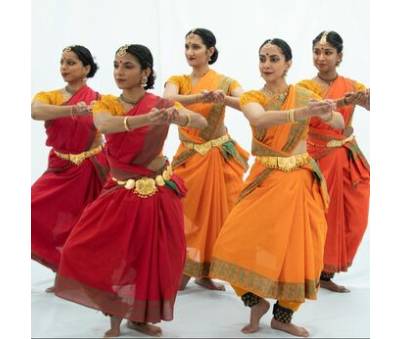 Drive East 2021 will be held in a hybrid format blending live theater with an online broadcast to allow for a global artist line-up and audience amid the COVID-19 pandemic. Artists evolve as we move forward in our careers; this year, we ask our artists to consider what it means to be a “conscious artist.” There is no universal answer, as each artist focuses on a myriad of aspects related to their performing art, such as sharing their choreography process to new artists, preserving lineage and traditions, opening up traditions that are normally closed off. What is consistent, however, is that conscious artists are always thinking about how they will impact the field around them, and why their contribution to the tradition of the form is valuable. Drive East 2021 explores what becoming a conscious artist looks like, poses myriad questions of artists and audiences, and explores the many paths artists can take to distill the vision of growth and sustainability into action. (Pictured above: KalaisanKalaichelvan.
Drive East 2021 will be held in a hybrid format blending live theater with an online broadcast to allow for a global artist line-up and audience amid the COVID-19 pandemic. Artists evolve as we move forward in our careers; this year, we ask our artists to consider what it means to be a “conscious artist.” There is no universal answer, as each artist focuses on a myriad of aspects related to their performing art, such as sharing their choreography process to new artists, preserving lineage and traditions, opening up traditions that are normally closed off. What is consistent, however, is that conscious artists are always thinking about how they will impact the field around them, and why their contribution to the tradition of the form is valuable. Drive East 2021 explores what becoming a conscious artist looks like, poses myriad questions of artists and audiences, and explores the many paths artists can take to distill the vision of growth and sustainability into action. (Pictured above: KalaisanKalaichelvan.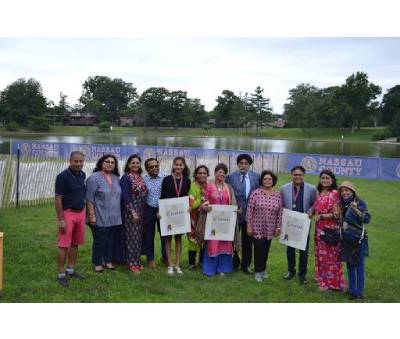
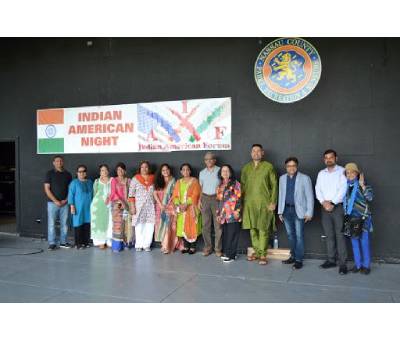
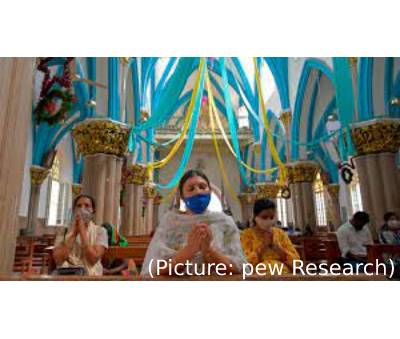 Three-quarters of Indian Christians (76%) say religion is very important in their lives, and Indian Christians engage in a variety of traditional beliefs and practices. Nearly all Indian Christians (98%) say they believe in God, and Christians in India are more likely than most other religious communities to say they pray daily (77%). Most Indian Christians also attend church weekly (55%), and an overwhelming share give money to a church (89%). At the same time, even though 78% of Indian Christians say they read or listen to the Bible at least weekly, smaller shares say they hold several traditional beliefs rooted in the Bible, including belief in Judgment Day (49%) and miracles (48%).
Three-quarters of Indian Christians (76%) say religion is very important in their lives, and Indian Christians engage in a variety of traditional beliefs and practices. Nearly all Indian Christians (98%) say they believe in God, and Christians in India are more likely than most other religious communities to say they pray daily (77%). Most Indian Christians also attend church weekly (55%), and an overwhelming share give money to a church (89%). At the same time, even though 78% of Indian Christians say they read or listen to the Bible at least weekly, smaller shares say they hold several traditional beliefs rooted in the Bible, including belief in Judgment Day (49%) and miracles (48%).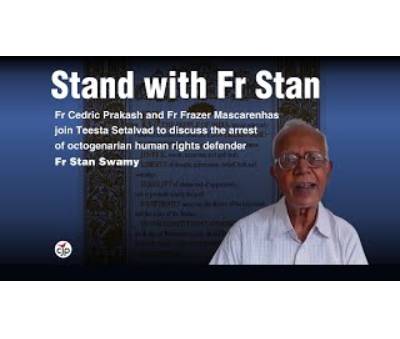 Bhima Koregaon incidence took place in 2019, 1st July. As thousands of dalits were returning after paying homage to dalits who lost their life in battle against Peshwa army in 1818, they were attacked. This battle had taken place between the Peshwa Baji Rao’s upper caste army against the East India Company’s army constituted mainly by Mahar community. Mahars saw it as a defeat of casteist forces and celebrated the victory, a victory pole was erected and annually dalits started visiting the place as a mark of defeat of Brahmanical forces. Babasaheb Ambedkar also visited the place in 1928. It became an ideological identity booster for the dalit community.
Bhima Koregaon incidence took place in 2019, 1st July. As thousands of dalits were returning after paying homage to dalits who lost their life in battle against Peshwa army in 1818, they were attacked. This battle had taken place between the Peshwa Baji Rao’s upper caste army against the East India Company’s army constituted mainly by Mahar community. Mahars saw it as a defeat of casteist forces and celebrated the victory, a victory pole was erected and annually dalits started visiting the place as a mark of defeat of Brahmanical forces. Babasaheb Ambedkar also visited the place in 1928. It became an ideological identity booster for the dalit community.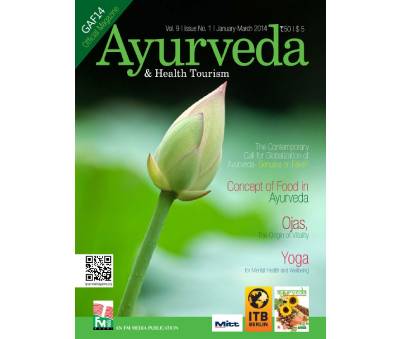 Apart from engaging in research activities, the centre publishes periodicals and books on Ayurveda, cultivates medicinal plants and organizes educational programmes. The founder, Dr P. S. Varier, started the Ayurveda Pathasala in 1917 which later became Vaidyaratnam P. S. Varier Ayurveda College. AVS also runs a Kathakali academy, named P. S. V. Natyasangham, where the classical dance form is taught and performed. P. S. V. Natyasangham is known for its strict adherence to the classical tenets of performance and meticulous training, and has produced talented artistes. A museum that preserves the personal belongings of Dr. Varier and documents the milestones in the history of Arya Vaidya Sala was established in 2002. It also chronicles the renaissance in the field of Ayurveda and its history.
Apart from engaging in research activities, the centre publishes periodicals and books on Ayurveda, cultivates medicinal plants and organizes educational programmes. The founder, Dr P. S. Varier, started the Ayurveda Pathasala in 1917 which later became Vaidyaratnam P. S. Varier Ayurveda College. AVS also runs a Kathakali academy, named P. S. V. Natyasangham, where the classical dance form is taught and performed. P. S. V. Natyasangham is known for its strict adherence to the classical tenets of performance and meticulous training, and has produced talented artistes. A museum that preserves the personal belongings of Dr. Varier and documents the milestones in the history of Arya Vaidya Sala was established in 2002. It also chronicles the renaissance in the field of Ayurveda and its history. “There are a lot of people who would feel very confident saying that we know why and how people choose partners and become a couple and fall in love, but our research suggests that is not the case,” says lead author Danu Anthony Stinson, a psychology professor at the University of Victoria, Canada. “We might have a good understanding of how strangers become attracted to each other and start dating, but that’s simply not how most relationships begin.” The team analyzed data from nearly 1,900 university students and crowdsourced adults, with 68 percent reporting that their current or most recent romantic relationship began as a friendship. There was little variation across gender, level of education, or ethnic groups, but the rate of friends-first initiation was even higher among 20-somethings and within LGBTQ+ communities, with 85 percent of such couples beginning as friendships.
“There are a lot of people who would feel very confident saying that we know why and how people choose partners and become a couple and fall in love, but our research suggests that is not the case,” says lead author Danu Anthony Stinson, a psychology professor at the University of Victoria, Canada. “We might have a good understanding of how strangers become attracted to each other and start dating, but that’s simply not how most relationships begin.” The team analyzed data from nearly 1,900 university students and crowdsourced adults, with 68 percent reporting that their current or most recent romantic relationship began as a friendship. There was little variation across gender, level of education, or ethnic groups, but the rate of friends-first initiation was even higher among 20-somethings and within LGBTQ+ communities, with 85 percent of such couples beginning as friendships.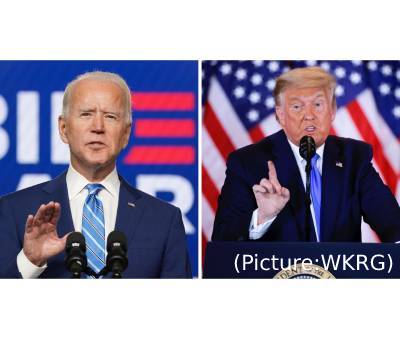 Five main factors account for Biden’s success.
Five main factors account for Biden’s success. The event was organized by the founder and President of the International Ahimsa Foundation Dr. Neeta Jain. Due to her persistent hard work and networking, Dr. Jain has been elected as an Indian American female Democratic District Leader in New York, at present representingAssembly District 25 Part B in Queens. She is an accomplished educator and civic & community leader. Being a Jain, she is a passionate advocate for non-violence and peace. To promote these values, she founded and presides over the International Ahimsa Foundation, a domestic non-profit organization founded in 2012 to promote the study and practice of non-violence and peace in educational institutes.
The event was organized by the founder and President of the International Ahimsa Foundation Dr. Neeta Jain. Due to her persistent hard work and networking, Dr. Jain has been elected as an Indian American female Democratic District Leader in New York, at present representingAssembly District 25 Part B in Queens. She is an accomplished educator and civic & community leader. Being a Jain, she is a passionate advocate for non-violence and peace. To promote these values, she founded and presides over the International Ahimsa Foundation, a domestic non-profit organization founded in 2012 to promote the study and practice of non-violence and peace in educational institutes.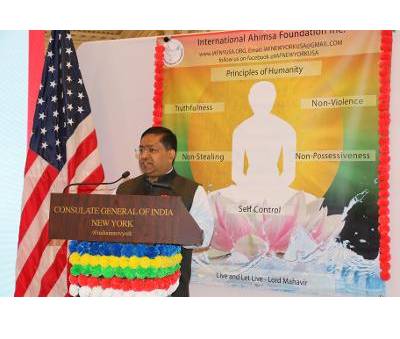 The Honorable Bishnu Prasad Gautam, Consul General of Nepal, NY, who spoke from the heart about the positive relationship and similar values between the Nepali and Indian diasporas and the importance of non-violence, peace, and unity. Sister Sabitha Geer, representative of the Brahma Kumaris to the United Nations, who spoke about the connection between awareness, attitude, vision, action, and the world, and guided the audience through some mindful meditation. Community leader Ashok Sancheti, who emphasized the importance of sharing and spreading happiness for prosperity and community success. NYC Mayor Bill de Blasio ofFice was represented by Mr. Rohan Narain, who read his letter to the audience and Queens borough President Donavon Richards office was represented by Mr. Brent Weitzberg.
The Honorable Bishnu Prasad Gautam, Consul General of Nepal, NY, who spoke from the heart about the positive relationship and similar values between the Nepali and Indian diasporas and the importance of non-violence, peace, and unity. Sister Sabitha Geer, representative of the Brahma Kumaris to the United Nations, who spoke about the connection between awareness, attitude, vision, action, and the world, and guided the audience through some mindful meditation. Community leader Ashok Sancheti, who emphasized the importance of sharing and spreading happiness for prosperity and community success. NYC Mayor Bill de Blasio ofFice was represented by Mr. Rohan Narain, who read his letter to the audience and Queens borough President Donavon Richards office was represented by Mr. Brent Weitzberg.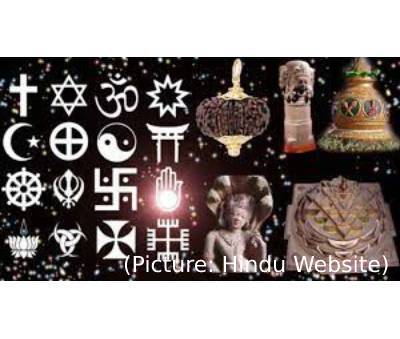 A major new Pew Research Center survey of religion across India, based on nearly 30,000 face-to-face interviews of adults conducted in 17 languages between late 2019 and early 2020 (before the
A major new Pew Research Center survey of religion across India, based on nearly 30,000 face-to-face interviews of adults conducted in 17 languages between late 2019 and early 2020 (before the 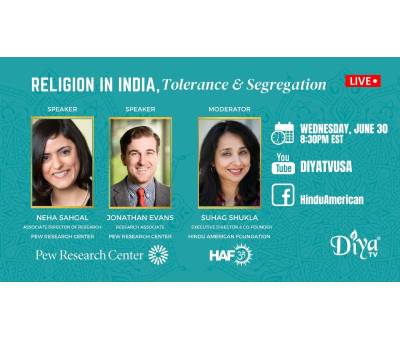 Even though Hindu BJP voters who link national identity with religion and language are more inclined to support a religiously segregated India, they also are more likely than other Hindu voters to express positive opinions about India’s religious diversity. Nearly two-thirds (65%) of this group – Hindus who say that being a Hindu and being able to speak Hindi are very important to be truly Indian and who voted for the BJP in 2019 – say religious diversity benefits India, compared with about half (47%) of other Hindu voters. This finding suggests that for many Hindus, there is no contradiction between valuing religious diversity (at least in principle) and feeling that Hindus are somehow more authentically Indian than fellow citizens who follow other religions.
Even though Hindu BJP voters who link national identity with religion and language are more inclined to support a religiously segregated India, they also are more likely than other Hindu voters to express positive opinions about India’s religious diversity. Nearly two-thirds (65%) of this group – Hindus who say that being a Hindu and being able to speak Hindi are very important to be truly Indian and who voted for the BJP in 2019 – say religious diversity benefits India, compared with about half (47%) of other Hindu voters. This finding suggests that for many Hindus, there is no contradiction between valuing religious diversity (at least in principle) and feeling that Hindus are somehow more authentically Indian than fellow citizens who follow other religions.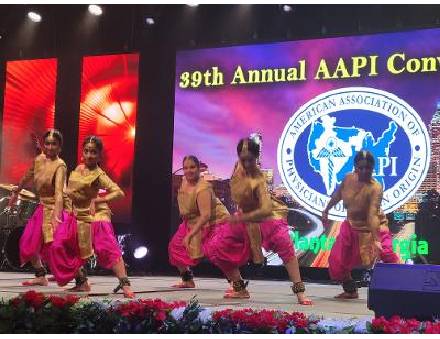 “Remembering and memorializing the brave AAPI Warriors and thousands of healthcare workers, who have sacrificed their lives at the service of humanity, especially during the Deadly Covid Pandemic is the major theme during the Convention,” said Dr. Sudhakar Jonnalagadda, President of AAPI. “This convention is a tribute to those who have lost their lives and to the frontline medical professionals who are at the forefront, combating the pandemic around the globe,” he added.
“Remembering and memorializing the brave AAPI Warriors and thousands of healthcare workers, who have sacrificed their lives at the service of humanity, especially during the Deadly Covid Pandemic is the major theme during the Convention,” said Dr. Sudhakar Jonnalagadda, President of AAPI. “This convention is a tribute to those who have lost their lives and to the frontline medical professionals who are at the forefront, combating the pandemic around the globe,” he added.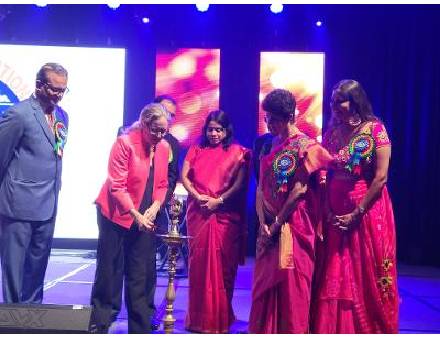 The annual convention this year is being organized by AAPI’s Atlanta Chapter, chaired by Dr. Sreeni Gangasani. The inaugural Nite’s Gala was hosted by Georgia Association of Physicians of Indian Origin (GAPI), during which several leaders of GAPI, including Drs. Indrani Indrakrishnan, Raghu Lolabhattu, Manoj Shah, Yogesh Joshi, Arvind Gupta, PB Rao, Dilip Patel, Uma Jonnagalada and Tarun Gosh addressed the audience. In her address, Dr. Indrani Indrakrishnan shared with the audience of GAPI’s educational, philanthropic, humanitarian, political, entertaining and social activities. Educational scholarships were presented to deserving students from the region.
The annual convention this year is being organized by AAPI’s Atlanta Chapter, chaired by Dr. Sreeni Gangasani. The inaugural Nite’s Gala was hosted by Georgia Association of Physicians of Indian Origin (GAPI), during which several leaders of GAPI, including Drs. Indrani Indrakrishnan, Raghu Lolabhattu, Manoj Shah, Yogesh Joshi, Arvind Gupta, PB Rao, Dilip Patel, Uma Jonnagalada and Tarun Gosh addressed the audience. In her address, Dr. Indrani Indrakrishnan shared with the audience of GAPI’s educational, philanthropic, humanitarian, political, entertaining and social activities. Educational scholarships were presented to deserving students from the region.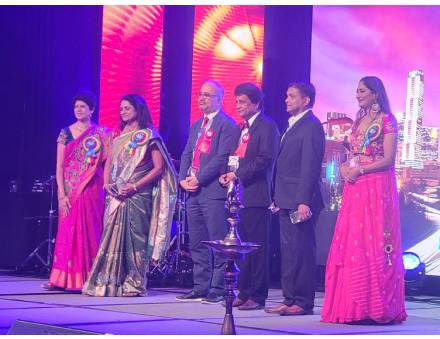 Dr. Kulkarni shared with the audience about the many programs and plans offered by the Government of India to alleviate the sufferings of the people of India during the pandemic. Dr. Kulkarni stressed the importance of Indo-US Strategic Alliance, especially in the health sector, while pointing out India’s contributions providing the world with quality drugs for cheaper prizes. Congresswoman Carolyn Bourdeaux representing the 7th Congressional district of Georgia was introduced to the audience by Dr. Sreeni Gangasani. Sharing her own close association with the South Asian community, Rep. Carolyn Bourdeaux said, her district is home to the largest South Asian population in the South East. “I have so many wonderful friends in this community for many years I have had many friends who are from South Asia,” she said. “I have been in Washington for about 6 months and I have worked very hard to Advocate on behalf of the South Asian Community.”
Dr. Kulkarni shared with the audience about the many programs and plans offered by the Government of India to alleviate the sufferings of the people of India during the pandemic. Dr. Kulkarni stressed the importance of Indo-US Strategic Alliance, especially in the health sector, while pointing out India’s contributions providing the world with quality drugs for cheaper prizes. Congresswoman Carolyn Bourdeaux representing the 7th Congressional district of Georgia was introduced to the audience by Dr. Sreeni Gangasani. Sharing her own close association with the South Asian community, Rep. Carolyn Bourdeaux said, her district is home to the largest South Asian population in the South East. “I have so many wonderful friends in this community for many years I have had many friends who are from South Asia,” she said. “I have been in Washington for about 6 months and I have worked very hard to Advocate on behalf of the South Asian Community.”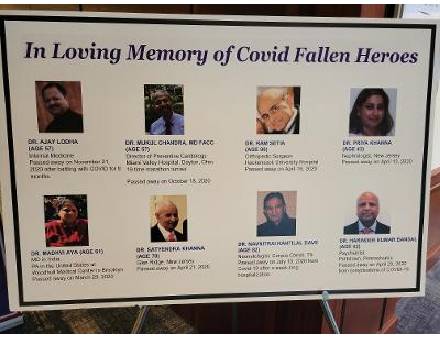 Describing herself as a friend of India and Indian Americans, the Congresswoman said, she is an active member of the India Caucus in the House, she said, “India is a very very important strategic partner to the United States,” and promised to work with the federal government in helping India especially during the pandemic. The inaugural nite’s star attraction was the young and energetic artist Vidya Vox who entertained the audience with song, music and dances. During the nearly 2 hours long live performance. She showcased the influences of her Indian-American heritage to create music that is refreshingly unique and contemporary, seamlessly fusing together the intricacies of Indian music with elements of electronic and hip-hop for an undeniably catchy sound. The delegates were presented with live performances of Bhartanatyam, Thillana and fusion dances by local artists, displaying unique talents in Indian classical dance forms. The popular and much loved Mehfil E Khaas provided AAPI members and families a platform to showcase their talents impromptu, in music, dance, jokes and Shero Shayari in an informal setting.
Describing herself as a friend of India and Indian Americans, the Congresswoman said, she is an active member of the India Caucus in the House, she said, “India is a very very important strategic partner to the United States,” and promised to work with the federal government in helping India especially during the pandemic. The inaugural nite’s star attraction was the young and energetic artist Vidya Vox who entertained the audience with song, music and dances. During the nearly 2 hours long live performance. She showcased the influences of her Indian-American heritage to create music that is refreshingly unique and contemporary, seamlessly fusing together the intricacies of Indian music with elements of electronic and hip-hop for an undeniably catchy sound. The delegates were presented with live performances of Bhartanatyam, Thillana and fusion dances by local artists, displaying unique talents in Indian classical dance forms. The popular and much loved Mehfil E Khaas provided AAPI members and families a platform to showcase their talents impromptu, in music, dance, jokes and Shero Shayari in an informal setting.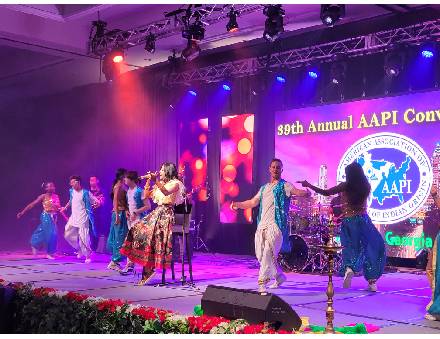 Physicians of Indian Origin in the United States are reputed to be leading health care providers, holding crucial positions in various hospitals and health care facilities around the nation and the world. Known to be a leading ethnic medical organization that represents nearly 100,000 physicians and fellows of Indian Origin in the US, and being their voice and providing a forum to its members to collectively work together to meet their diverse needs, AAPI members are proud to contribute to the wellbeing of their motherland India and their adopted land, the United States. The convention is forum to network, share knowledge and thoughts, and thus, enrich one another, and rededicate ourselves for the health and wellbeing of all peoples of the world.
Physicians of Indian Origin in the United States are reputed to be leading health care providers, holding crucial positions in various hospitals and health care facilities around the nation and the world. Known to be a leading ethnic medical organization that represents nearly 100,000 physicians and fellows of Indian Origin in the US, and being their voice and providing a forum to its members to collectively work together to meet their diverse needs, AAPI members are proud to contribute to the wellbeing of their motherland India and their adopted land, the United States. The convention is forum to network, share knowledge and thoughts, and thus, enrich one another, and rededicate ourselves for the health and wellbeing of all peoples of the world.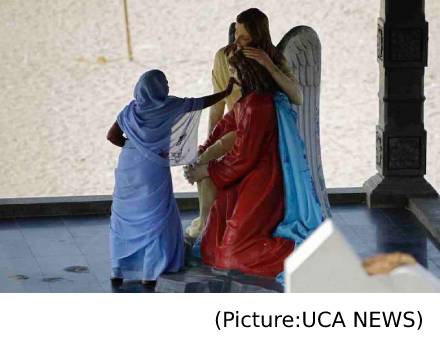 Most Indians share some common values and beliefs across religious lines like karma, Sufism or respecting elders, which is considered very important to their faiths. The survey also found Indians tend to see religious ceremonies for the three rites of passage at birth (or infancy), marriage and death as highly important. “For example, the vast majority of Muslims (92 percent), Christians (86 percent) and Hindus (85 percent) say it is very important to have a religious burial or cremation for their loved ones.” And yet members of major religious communities also tend to see themselves as very different from others.
Most Indians share some common values and beliefs across religious lines like karma, Sufism or respecting elders, which is considered very important to their faiths. The survey also found Indians tend to see religious ceremonies for the three rites of passage at birth (or infancy), marriage and death as highly important. “For example, the vast majority of Muslims (92 percent), Christians (86 percent) and Hindus (85 percent) say it is very important to have a religious burial or cremation for their loved ones.” And yet members of major religious communities also tend to see themselves as very different from others.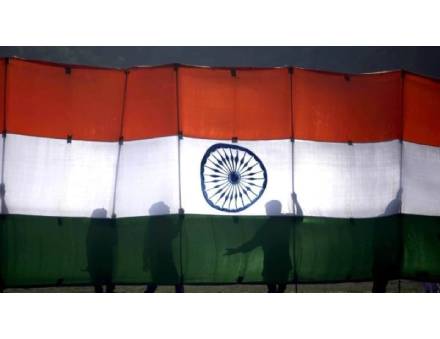 But Indians’ commitment to tolerance is accompanied by a strong preference for keeping religious communities segregated. For example, Indians generally say they do not have much in common with members of other religious groups, and large majorities in the six major groups say their close friends come mainly or entirely from their own religious community. That’s true not only for 86% of India’s large Hindu population, but also for smaller groups such as Sikhs (80%) and Jains (72%). Moreover, roughly two-thirds of Hindus say it is very important to stop Hindu women (67%) or Hindu men (65%) from marrying into other religious communities. Even larger shares of Muslims oppose interreligious marriage: 80% say it is very important to stop Muslim women from marrying outside their religion, and 76% say it is very important to stop Muslim men from doing so.
But Indians’ commitment to tolerance is accompanied by a strong preference for keeping religious communities segregated. For example, Indians generally say they do not have much in common with members of other religious groups, and large majorities in the six major groups say their close friends come mainly or entirely from their own religious community. That’s true not only for 86% of India’s large Hindu population, but also for smaller groups such as Sikhs (80%) and Jains (72%). Moreover, roughly two-thirds of Hindus say it is very important to stop Hindu women (67%) or Hindu men (65%) from marrying into other religious communities. Even larger shares of Muslims oppose interreligious marriage: 80% say it is very important to stop Muslim women from marrying outside their religion, and 76% say it is very important to stop Muslim men from doing so.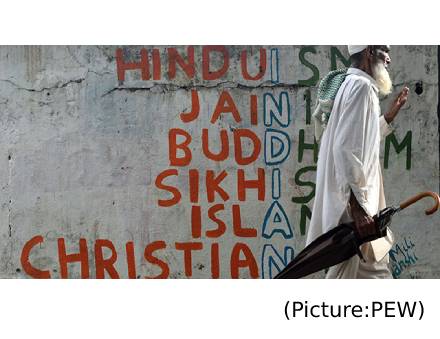 An overall pattern of stability in the share of religious groups is accompanied by little net change from movement into, or out of, most religious groups. Among Hindus, for instance, any conversion out of the group is matched by conversion into the group: 0.7% of respondents say they were raised Hindu but now identify as something else, and roughly the same share (0.8%) say they were not raised Hindu but now identify as Hindu. For Christians, however, there are some net gains from conversion: 0.4% of survey respondents are former Hindus who now identify as Christian, while 0.1% were raised Christian but have since left Christianity.
An overall pattern of stability in the share of religious groups is accompanied by little net change from movement into, or out of, most religious groups. Among Hindus, for instance, any conversion out of the group is matched by conversion into the group: 0.7% of respondents say they were raised Hindu but now identify as something else, and roughly the same share (0.8%) say they were not raised Hindu but now identify as Hindu. For Christians, however, there are some net gains from conversion: 0.4% of survey respondents are former Hindus who now identify as Christian, while 0.1% were raised Christian but have since left Christianity. On the occasion, United Nations General Assembly (UNGA) President VolkanBozkir said that yoga was a lifeline during the COVID-19 lockdown as it helps to maintain physical wellbeing and manage the stress of uncertainty and isolation. “The COVID 19 pandemic has clearly demonstrated the consequences of poor global health, the social and economic consequences have been devastating for many around the world. Yoga was a lifeline during lockdown,” Bozkir said in a statement on Monday. Earlier, the Indian Embassy in the United States on Sunday celebrated the IDY 2021 at the India House, with the theme “Yoga for Wellness”.
On the occasion, United Nations General Assembly (UNGA) President VolkanBozkir said that yoga was a lifeline during the COVID-19 lockdown as it helps to maintain physical wellbeing and manage the stress of uncertainty and isolation. “The COVID 19 pandemic has clearly demonstrated the consequences of poor global health, the social and economic consequences have been devastating for many around the world. Yoga was a lifeline during lockdown,” Bozkir said in a statement on Monday. Earlier, the Indian Embassy in the United States on Sunday celebrated the IDY 2021 at the India House, with the theme “Yoga for Wellness”. Ambassador Randhir Kumar Jaiswal, the Chief Guest, commented “Yoga is a way of life. The idea of Yoga is truly universal and it must be heard, celebrated and promoted in each and every part of our society and community. The key is to not just celebrate Yoga as a health practice, for it needs to be celebrated in its entirety,” asserted Jaiswal. He highlighted how the International Yoga Day has evolved into in major annual event that’s celebrated across the globe ever since Prime Minister Narendra Modi proposed the idea during his speech at the United Nations General Assembly back in September 2014.
Ambassador Randhir Kumar Jaiswal, the Chief Guest, commented “Yoga is a way of life. The idea of Yoga is truly universal and it must be heard, celebrated and promoted in each and every part of our society and community. The key is to not just celebrate Yoga as a health practice, for it needs to be celebrated in its entirety,” asserted Jaiswal. He highlighted how the International Yoga Day has evolved into in major annual event that’s celebrated across the globe ever since Prime Minister Narendra Modi proposed the idea during his speech at the United Nations General Assembly back in September 2014. The event was inaugurated by all attendees by chanting “Om” and Acharya Performing Arts Academy students performed the “NrithyaYogasana” which is “Dance Yoga” invented by artistic director guru Asha Adiga Acharya by combining yoga and Indian classical dance moves together, to benefit the Pada (Feet), Anga (Body) and Mudra(Fingers). “NupuraGeetha” dance ensemble team started the performance with beautiful Ganesha dance, pure Alaripu, Mallari dance, expression filled dance based on Vachana, Anathapurageethe dance and ended the program with Charishnu dance which was choreographed creatively with yoga poses.
The event was inaugurated by all attendees by chanting “Om” and Acharya Performing Arts Academy students performed the “NrithyaYogasana” which is “Dance Yoga” invented by artistic director guru Asha Adiga Acharya by combining yoga and Indian classical dance moves together, to benefit the Pada (Feet), Anga (Body) and Mudra(Fingers). “NupuraGeetha” dance ensemble team started the performance with beautiful Ganesha dance, pure Alaripu, Mallari dance, expression filled dance based on Vachana, Anathapurageethe dance and ended the program with Charishnu dance which was choreographed creatively with yoga poses. Gender difference is intimately stitched into the fabric of humanness. At
Gender difference is intimately stitched into the fabric of humanness. At 
 BR will serve as THE ONLY tech platform on which smaller retailers can personally select products from verified suppliers across various categories with minimum MOQs (in most cases, just ONE product per style). Since most sellers and buyers are unable to produce or procure volumes during these uncertain times, BR serves as the perfect matchmaking service for these small-to-mid-size businesses looking for alternative avenues.
BR will serve as THE ONLY tech platform on which smaller retailers can personally select products from verified suppliers across various categories with minimum MOQs (in most cases, just ONE product per style). Since most sellers and buyers are unable to produce or procure volumes during these uncertain times, BR serves as the perfect matchmaking service for these small-to-mid-size businesses looking for alternative avenues. The exhibition is comprised of monumental canvases that document Sharma’s travels around India and its vicinity, exploring the relationships between urbanization, landscapes and the human presence at the interstices of modernity. Sharma is constantly expanding and evolving these images so that they add new connotations and dimensions to that which was already familiar. We sincerely hope you can join us at the opening reception.
The exhibition is comprised of monumental canvases that document Sharma’s travels around India and its vicinity, exploring the relationships between urbanization, landscapes and the human presence at the interstices of modernity. Sharma is constantly expanding and evolving these images so that they add new connotations and dimensions to that which was already familiar. We sincerely hope you can join us at the opening reception. Tagore, the poet of Indian nationalism, was India’s pre-eminent cultural and literary personality of the twentieth century. The influence of the Buddha on his poetry and his novels has been much studied and written about. This influence came about in diverse ways. His immediate family was steeped in Buddhist study. In 1859 his father Debendranath Tagore had been to Ceylon and had come back with not just knowledge of but keen interest in the Buddha’s life and his teachings. He wrote Sakya Muni O NirvanTattvai in 1882. Satyendranath Tagore, Rabindranath’s elder brother, who had accompanied their father to Ceylon, wrote Bauddha Dharma in 1901. The BrahmoSamaj, of which the Tagore family was an integral part, had also taken up the study of the Buddha’s teachings. A very early influence regarding the Buddha on Rabindranath Tagore was that of RajendralalaMitra, who has figured in this narrative earlier.
Tagore, the poet of Indian nationalism, was India’s pre-eminent cultural and literary personality of the twentieth century. The influence of the Buddha on his poetry and his novels has been much studied and written about. This influence came about in diverse ways. His immediate family was steeped in Buddhist study. In 1859 his father Debendranath Tagore had been to Ceylon and had come back with not just knowledge of but keen interest in the Buddha’s life and his teachings. He wrote Sakya Muni O NirvanTattvai in 1882. Satyendranath Tagore, Rabindranath’s elder brother, who had accompanied their father to Ceylon, wrote Bauddha Dharma in 1901. The BrahmoSamaj, of which the Tagore family was an integral part, had also taken up the study of the Buddha’s teachings. A very early influence regarding the Buddha on Rabindranath Tagore was that of RajendralalaMitra, who has figured in this narrative earlier.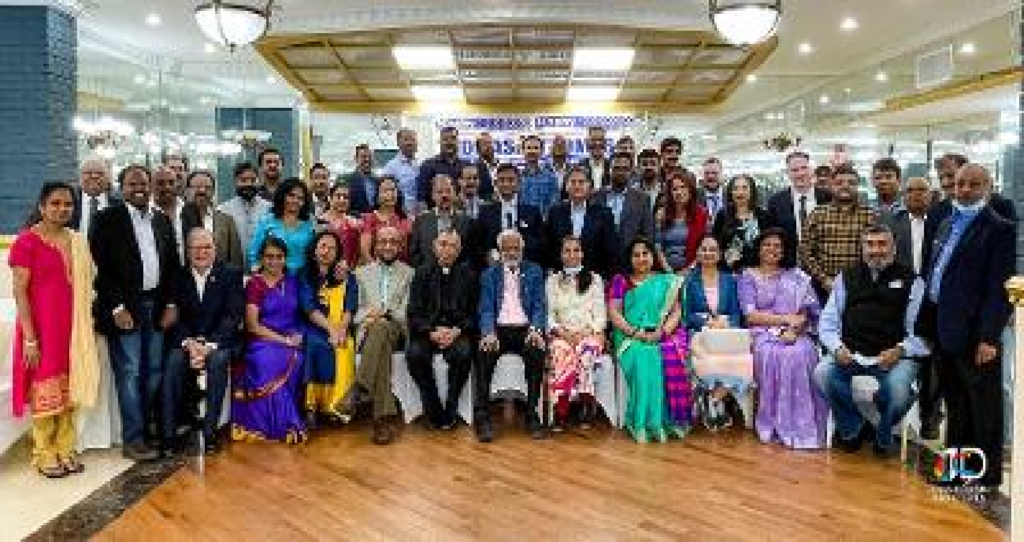 Those who participated in the prayer include Guru jiGarud Gopal Prabhu, Father John Thomas of Jackson Heights Orthodox Church, Imam Muhammad Waliullah of Hillside Islamic Center, Ashok Vyas of ITV, Hemanth Shah of FBIMA, Suhag Mehta of Ganesh Utsav, Kripal Singh, VirendraVora, Paul Karukapally, Ashok Vora, Philipose Philip, V.M. Chacko, Varghese Abraham, Mercedes Buchanan and George Abraham of IOCUSA.
Those who participated in the prayer include Guru jiGarud Gopal Prabhu, Father John Thomas of Jackson Heights Orthodox Church, Imam Muhammad Waliullah of Hillside Islamic Center, Ashok Vyas of ITV, Hemanth Shah of FBIMA, Suhag Mehta of Ganesh Utsav, Kripal Singh, VirendraVora, Paul Karukapally, Ashok Vora, Philipose Philip, V.M. Chacko, Varghese Abraham, Mercedes Buchanan and George Abraham of IOCUSA.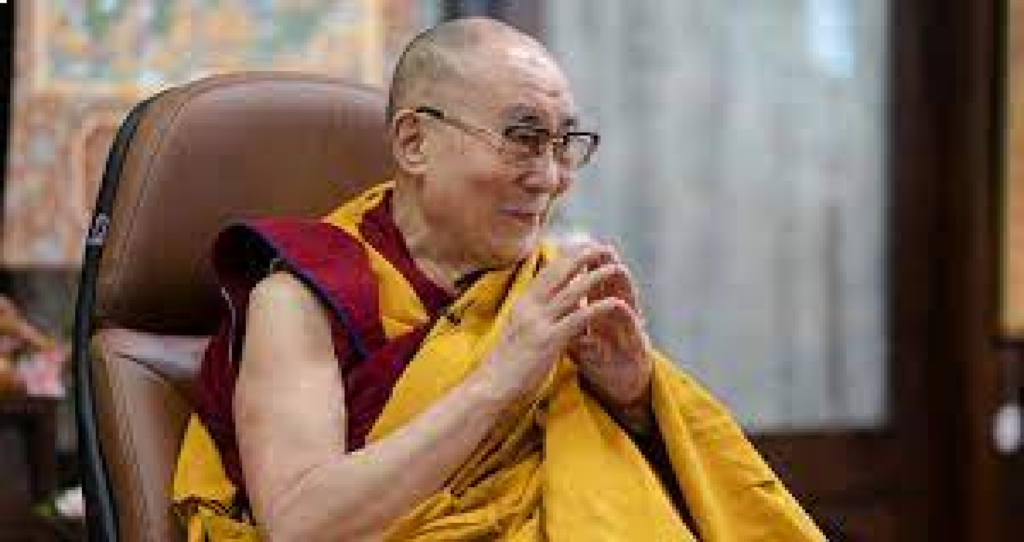 On query of Professor Medvedev that what value the study of ‘thukdam’ could have for humanity in general. The spiritual leader replied Tibetan Buddhists believe that people go through a process of dissolution in the course of death.
On query of Professor Medvedev that what value the study of ‘thukdam’ could have for humanity in general. The spiritual leader replied Tibetan Buddhists believe that people go through a process of dissolution in the course of death.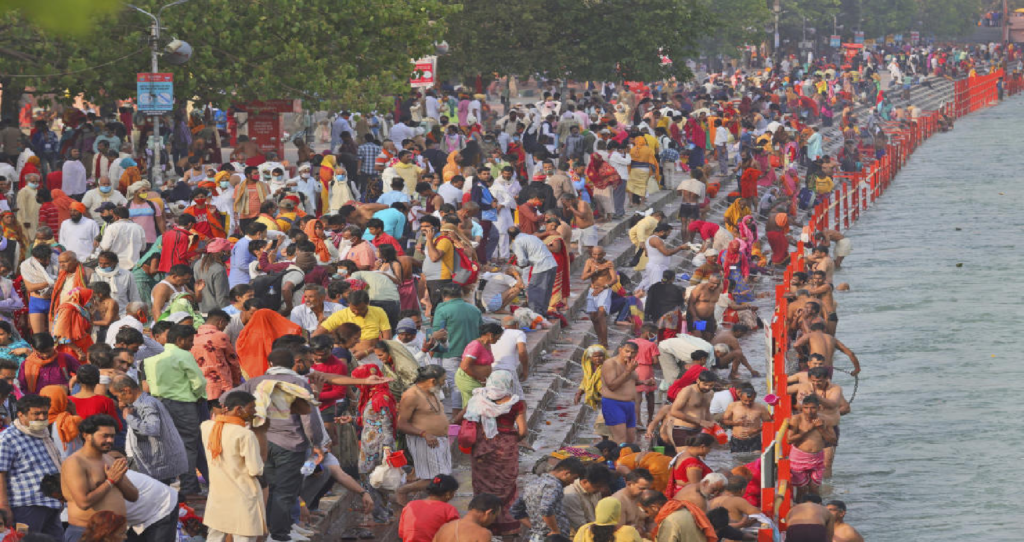 Hindus believe the river is holy and bathing in it will cleanse them of their sins and bring salvation. The Kumbh Mela takes place every 12 years and the venue is chosen from amongst four cities, including Allahabad, Haridwar, Nasik and Ujjain. Haridwar’s turn to host the gathering came amid a sharp rise in the number of coronavirus infections, with India consistently reporting more than 100,000 cases daily in the past few weeks.
Hindus believe the river is holy and bathing in it will cleanse them of their sins and bring salvation. The Kumbh Mela takes place every 12 years and the venue is chosen from amongst four cities, including Allahabad, Haridwar, Nasik and Ujjain. Haridwar’s turn to host the gathering came amid a sharp rise in the number of coronavirus infections, with India consistently reporting more than 100,000 cases daily in the past few weeks.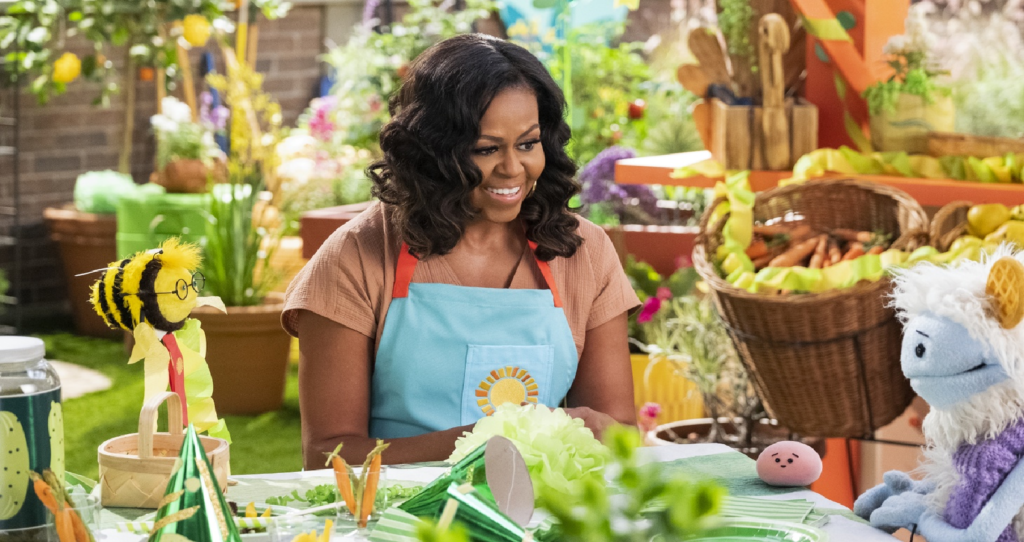 In Waffles + Mochi, the puppets learn how to make mazamorra morada, a sweet purple corn desert, in Lamay, Peru. Each episode is focused around a specific ingredient. In the sixth episode, the puppets are sent on a mission to collect different types of eggs to bring to chef
In Waffles + Mochi, the puppets learn how to make mazamorra morada, a sweet purple corn desert, in Lamay, Peru. Each episode is focused around a specific ingredient. In the sixth episode, the puppets are sent on a mission to collect different types of eggs to bring to chef 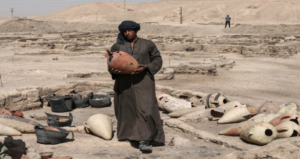 Archaeologists started excavating in September in the area between the temples of King Ramses III and Amenhotep III. The original goal of the mission was to find King Tutankhamen’s mortuary temple, the statement said.
Archaeologists started excavating in September in the area between the temples of King Ramses III and Amenhotep III. The original goal of the mission was to find King Tutankhamen’s mortuary temple, the statement said. According to Beall, orthodox work on the incarnation begins with the standard doctrine that Christ is fully divine and fully human — having all properties that are essential to God but also all properties that are essential to being human, including all the essential limitations of being human. Philosophers and theologians have long struggled with this tension and, in a quest for logical consistency, have articulated theories that attempt to dissolve the apparent contradiction.
According to Beall, orthodox work on the incarnation begins with the standard doctrine that Christ is fully divine and fully human — having all properties that are essential to God but also all properties that are essential to being human, including all the essential limitations of being human. Philosophers and theologians have long struggled with this tension and, in a quest for logical consistency, have articulated theories that attempt to dissolve the apparent contradiction.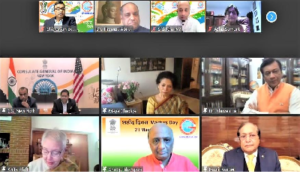 Consul General Jaiswal, in his address, commended GOPIO Manhattan for organizing the event and several others, honoring India and Indians. “Today is the Red Letter Day in the history of India,” the Indian diplomat with over three decades of diplomatic services around the world, told the hundreds of community leaders from around several continents who joined the celebration. “We honor today the legendary freedom fighters, recalling their bravery and love for our motherland.” Describing today’s celebrations as unique, Ambassador Jaiswal recalled the founding of the
Consul General Jaiswal, in his address, commended GOPIO Manhattan for organizing the event and several others, honoring India and Indians. “Today is the Red Letter Day in the history of India,” the Indian diplomat with over three decades of diplomatic services around the world, told the hundreds of community leaders from around several continents who joined the celebration. “We honor today the legendary freedom fighters, recalling their bravery and love for our motherland.” Describing today’s celebrations as unique, Ambassador Jaiswal recalled the founding of the 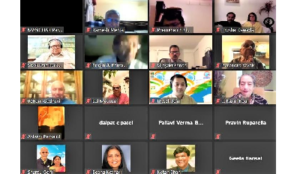 In 1913 Lala Har Dayal formed the Ghadar Party to organize a rebellion against the British government of India. He fled to Switzerland and then to Berlin, where he tried to foment an anti-British rising in northwestern India. After the German defeat in World War I, Har Dayal settled in Stockholm as a professor of Indian Philosophy and wrote Forty-Four Months in Germany and Turkey. He moved to the USA in the late 1920s and became a Professor of Sanskrit at the University of California, Berkeley.
In 1913 Lala Har Dayal formed the Ghadar Party to organize a rebellion against the British government of India. He fled to Switzerland and then to Berlin, where he tried to foment an anti-British rising in northwestern India. After the German defeat in World War I, Har Dayal settled in Stockholm as a professor of Indian Philosophy and wrote Forty-Four Months in Germany and Turkey. He moved to the USA in the late 1920s and became a Professor of Sanskrit at the University of California, Berkeley.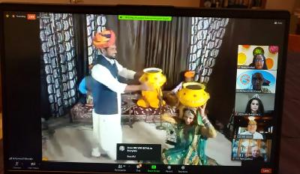 Holi has become known as India’s most vivid, joyous-festival. Holi is being celebrated in the Indian subcontinent for centuries, with poems documenting celebrations dating back to the 4th century CE. It marks the beginning of spring after a long winter, symbolic of the triumph of good over evil. It is celebrated in March, corresponding to the Hindu calendar month of Phalguna. On the eve of the festival, large pyres are lit in many parts of India to signify the burning of evil spirits. People often throw wood, dried leaves and twigs into bonfires, Ambassador Jaiswal explained.
Holi has become known as India’s most vivid, joyous-festival. Holi is being celebrated in the Indian subcontinent for centuries, with poems documenting celebrations dating back to the 4th century CE. It marks the beginning of spring after a long winter, symbolic of the triumph of good over evil. It is celebrated in March, corresponding to the Hindu calendar month of Phalguna. On the eve of the festival, large pyres are lit in many parts of India to signify the burning of evil spirits. People often throw wood, dried leaves and twigs into bonfires, Ambassador Jaiswal explained.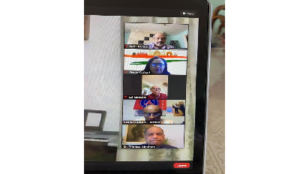 “The vibrancy of colors is something that brings in a lot of positivity in our lives and Holi being the festival of colors is actually a day worth rejoicing,” Motwani said. “Holi is considered as one of the most revered and celebrated festivals of India and it is celebrated in almost every part of India, transcending every region, and people of all faiths, including Hindus, Muslims, Sikhs, Christians, Parsees, Buddhists, and Jains. It represents the uniqueness of Indian culture as we, from all backgrounds stand united to welcome Spring, as Mother Nature breathes freshness into our lives and that of every living creature on Earth. Welcome to each and every one of you and wishing you and your families A VERY HAPPY HOLI!”
“The vibrancy of colors is something that brings in a lot of positivity in our lives and Holi being the festival of colors is actually a day worth rejoicing,” Motwani said. “Holi is considered as one of the most revered and celebrated festivals of India and it is celebrated in almost every part of India, transcending every region, and people of all faiths, including Hindus, Muslims, Sikhs, Christians, Parsees, Buddhists, and Jains. It represents the uniqueness of Indian culture as we, from all backgrounds stand united to welcome Spring, as Mother Nature breathes freshness into our lives and that of every living creature on Earth. Welcome to each and every one of you and wishing you and your families A VERY HAPPY HOLI!”